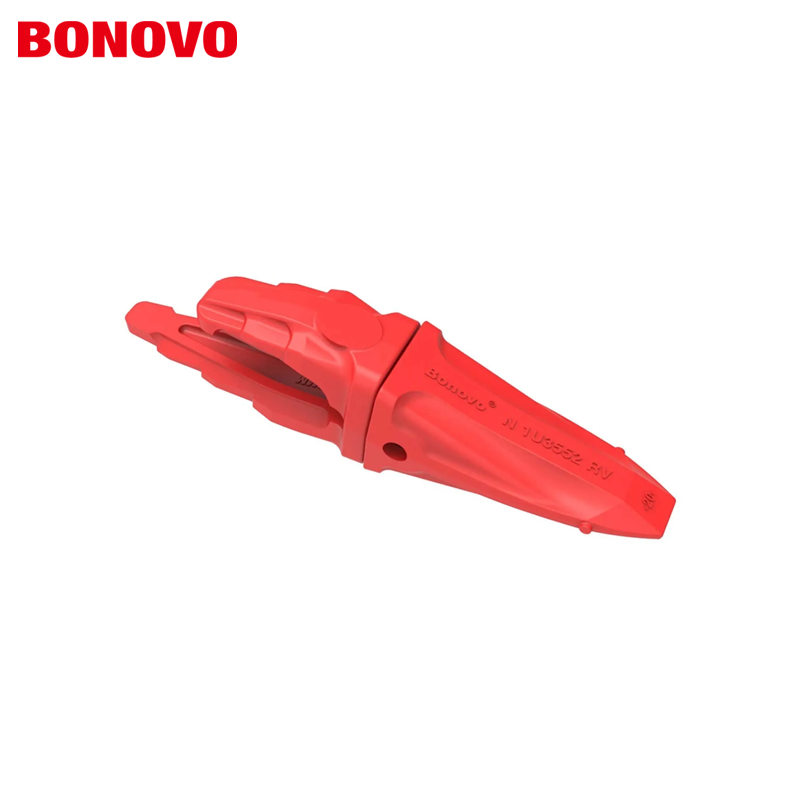
Observation of the degree of wear on the exterior
Tips of bucket teeth wear: "How to judge the tips of bucket teeth for excavators" is the primary observation point. For normal use of bucket teeth, the tips should remain relatively sharp. If the tips of bucket teeth become blunt and the wear exceeds one-third of the original size, this indicates that the bucket teeth have been excessively worn. In earthwork excavation operations, sharp bucket teeth can easily cut into the soil, while blunt bucket teeth will increase excavation resistance and reduce work efficiency. At this time, it is necessary to consider replacing bucket teeth to avoid affecting the overall progress of the operation.
Side wear of bucket teeth: Pay attention to the side of the bucket teeth to see if there are obvious "signs of side wear of excavator bucket teeth". When the side wear is severe, causing the thickness of the bucket teeth to become significantly thinner, close to or less than the safe use thickness, the strength of the bucket teeth will drop significantly. When excavating harder materials, such as rocks, it is easy to break, which will not only damage the bucket teeth, but also may cause damage to the excavator bucket, so the bucket teeth must be replaced in time in this case.
Perception of changes in excavation performance
Reduced excavation efficiency: If the excavator is found to have "reduced excavation efficiency due to bucket tooth problems", this is an important signal that the bucket teeth need to be replaced. When the bucket teeth are severely worn, the time required to dig the same volume of material will increase significantly. For example, in daily mining operations, the originally efficient digging process becomes sluggish, and the time to dig a shovel of material is much longer than normal. This is likely to be due to the wear of the bucket teeth affecting the digging performance. The bucket teeth should be checked as soon as possible and replaced.
Insufficient digging force: Feel the "influence of excavator bucket tooth wear on digging force" when the excavator is working. Normal bucket teeth can effectively transfer the excavator's digging force to the material to achieve efficient digging. However, worn bucket teeth will disperse the digging force and cannot be concentrated on the material. When digging hard soil or frozen soil, if the excavator has obvious "insufficient digging force and difficulty in cutting into the material", after excluding other mechanical failures, it is likely that the bucket teeth have reached the replacement cycle.
Check the connection of the bucket teeth
Loose connection: Check the connection between the bucket teeth and the bucket, and pay attention to whether there is a problem of "judgment and treatment of loose connection of excavator bucket teeth". Under the long-term impact and vibration of the bucket teeth, the bolts or pins at the connection may loosen. If the bucket teeth are found to be shaking, this will not only affect the stability of the excavation operation, but may also cause the bucket teeth to fall off during the operation. Once the connection is loose, it should be tightened in time; if the connection part cannot be effectively tightened due to wear and other reasons, the bucket teeth and related connection parts need to be replaced.
Wear of the connection part: Carefully check the wear of the bucket tooth connection part, and pay attention to "Wear degree assessment of the connection part of the excavator bucket teeth". If the wear of the connection part is serious, there will be problems such as excessive gap or deformation, which will affect the installation accuracy and stability of the bucket teeth, and then affect the excavation effect. In this case, even if the main body of the bucket teeth is not seriously worn, the bucket teeth need to be replaced to ensure a firm connection and ensure the safety and efficiency of the excavation operation.
Analysis of bucket tooth material characteristics
Material hardness reduction: Bucket teeth of different materials have different hardness standards. Pay attention to "The hardness change and replacement relationship of the excavator bucket tooth material". After long-term use, the hardness of the bucket tooth material may decrease due to wear and impact. It can be tested by professional hardness testing tools. If the hardness of the bucket teeth is lower than the specified minimum value, its wear resistance and impact resistance will be greatly reduced. Continuing to use is likely to cause excessive wear and damage. At this time, the bucket teeth should be replaced in time.
Material fatigue damage: Observe whether there are "signs of fatigue damage to the excavator bucket teeth material" on the surface of the bucket teeth. Under frequent impact and alternating stress, fatigue cracks may appear in the bucket teeth material. Even if these cracks are very small at the beginning, as the operation continues, the cracks will gradually expand and eventually cause the bucket teeth to break.
Choose BONOVO for high-quality, customizable brush cutters for skid steers with fast delivery. Contact us today to discover how our superior products can enhance your land management tasks!

 Hot News
Hot News2024-09-18
2024-09-18
2024-07-03
2024-03-08
2024-03-08
2024-03-08